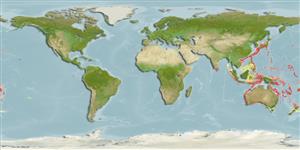Environment: milieu / climate zone / depth range / distribution range
Ecologia
marino batidemersale; distribuzione batimetrica 200 - 400 m (Ref. 9824). Deep-water
Indo-West Pacific: southern Japan (Ref. 559), southern Indonesia to northwest Australia, and New Caledonia.
Size / Peso / Age
Maturity: Lm ? range ? - ? cm
Max length : 20.3 cm SL maschio/sesso non determinato; (Ref. 9824)
Spine dorsali (totale) : 0; Raggi dorsali molli (totale) : 104 - 113; Spine anali: 0; Raggi anali molli: 83 - 90; Vertebre: 31 - 32. Caudal fin darkened on middle rays (Ref 42535). Related to P. coarctatus, but differs from it in having a small number of scales on the lateral line, larger eye, its diameter 3.5 times in head length, no dark blotches on lateral line and no dots along upper margin of upper eye.
Feeds on fishes, shrimps, and other small benthic animals (Ref. 9824). Marketed fresh or dried (Ref. 9824).
Life cycle and mating behavior
Maturities | Riproduzione | Spawnings | Egg(s) | Fecundities | Larve
Masuda, H., K. Amaoka, C. Araga, T. Uyeno and T. Yoshino, 1984. The fishes of the Japanese Archipelago. Vol. 1. Tokai University Press, Tokyo, Japan. 437 p. (text). (Ref. 559)
IUCN Red List Status (Ref. 130435)
Threat to humans
Harmless
Human uses
Pesca: commerciale
Strumenti
Special reports
Download XML
Fonti Internet
Estimates based on models
Preferred temperature (Ref.
123201): 3.3 - 18.9, mean 13.4 °C (based on 64 cells).
Phylogenetic diversity index (Ref.
82804): PD
50 = 0.5020 [Uniqueness, from 0.5 = low to 2.0 = high].
Bayesian length-weight: a=0.00912 (0.00408 - 0.02036), b=3.05 (2.87 - 3.23), in cm total length, based on LWR estimates for this (Sub)family-body shape (Ref.
93245).
Trophic level (Ref.
69278): 3.9 ±0.60 se; based on food items.
Resilienza (Ref.
120179): Medio, tempo minimo di raddoppiamento della popolazione 1.4 - 4.4 anni (Assuming tmax>3).
Fishing Vulnerability (Ref.
59153): Low vulnerability (15 of 100).
